Urbanizing the Mojave Desert: Las Vegas
978-3-939633-50-1
978-3-939633-50-1
Create successful ePaper yourself
Turn your PDF publications into a flip-book with our unique Google optimized e-Paper software.
URBANIZING THE MOJAVE DESERT:<br />
DIE URBANISIERUNG DER MOJAVE-WÜSTE:<br />
<strong>Urbanizing</strong> <strong>the</strong> <strong>Mojave</strong> <strong>Desert</strong>: <strong>Las</strong> <strong>Vegas</strong><br />
Die Urbanisierung der <strong>Mojave</strong>-Wüste: <strong>Las</strong> <strong>Vegas</strong><br />
LAS VEGAS<br />
NICOLE HUBER & RALPH STERN<br />
jovis
106
113
161
166
176
179
Epilogue<br />
191<br />
The images presented above do not project ideals of urban development or<br />
solve social and environmental problems. Ra<strong>the</strong>r, <strong>the</strong> images offer a “third<br />
sight” that makes visible <strong>the</strong> complex interstitial spaces of everyday production<br />
and consumption tied to physical and virtual place making as well as<br />
local and global investment. Locals have responded to <strong>the</strong>se images with<br />
comments such as “I see <strong>the</strong>se things everyday, but have never really ‘seen’<br />
<strong>the</strong>m before”. It is a classic architectural trope to “learn to see” and, heartened<br />
by such responses, we have learned to see a desert city beyond <strong>the</strong><br />
blinding lights of <strong>the</strong> <strong>Las</strong> <strong>Vegas</strong> Strip.<br />
<strong>Urbanizing</strong> <strong>the</strong> <strong>Mojave</strong> <strong>Desert</strong>: <strong>Las</strong> <strong>Vegas</strong> presents a profoundly complex<br />
environment, a hybrid landscape shaped and reshaped by practices of<br />
everyday urbanization. Such practices include <strong>the</strong> fragmented topo graphies<br />
of in- and exclusion (rears & edges) where confined sites of natural resources<br />
(p. 74) and segregated environments (p. 75) are mirrored by “exclusive”<br />
casinos (pp. 90, 92). In turn, such spectacular exclusivity conceals <strong>the</strong> peripheral<br />
role assigned various economic and social groups. These practices<br />
also include <strong>the</strong> de- and reterritorialization (signs & traces) associated with<br />
blending physical and virtual spaces that connect <strong>the</strong> desert landscape to<br />
imaginary realms of <strong>the</strong> spectacular (pp. 96, 106, 107), desire (pp. 97,<br />
105), power (pp. 99, 103), <strong>the</strong> exceptional (pp. 100–102), and <strong>the</strong> promised<br />
(pp. 108, 109). They illuminate conversions between land use and economics<br />
(mobility & stability), linking a transitory work force (pp. 113–15, 120,<br />
121) with <strong>the</strong> consumption of resources and commodities (pp. 112, 116–<br />
19, 122–27). They also network local and regional scales (providing & disposing)<br />
through infrastructures of energy production (pp. 130, 131, 133–<br />
35) and <strong>the</strong> topographies of waste- (pp. 137, 145) and water-management<br />
(pp.132, 138–40, 142–44). These practices fuse industrial and postindustrial<br />
activities (abstraction & extraction) with <strong>the</strong>ir leveled geographies<br />
(pp.150–61) and inscribed geometries (pp. 162, 163). Finally, <strong>the</strong>se are <strong>the</strong><br />
practices of imbrication (scraping & sprawling), overlapping landscapes of<br />
industrialized desire, exotic decorum, and environmental damage; exposing<br />
<strong>the</strong> proximity of topographies of extraction and construction (pp. 167, 184),<br />
<strong>the</strong> artificiality of water diversions and catchments (pp. 178, 185, 186), imported<br />
landscapes (pp. 170–75, 185, 187–89), and constructions ranging<br />
from Italian villas to “cosmopolitan” blocks.<br />
As such, <strong>Urbanizing</strong> <strong>the</strong> <strong>Mojave</strong> <strong>Desert</strong>: <strong>Las</strong> <strong>Vegas</strong> reframes <strong>the</strong> seamless<br />
surfaces of draped neon lights, curtain walls, and landscape features<br />
layered onto <strong>the</strong> <strong>Mojave</strong>’s stark topography, uncovering distinct strata that<br />
respatialize <strong>the</strong> social, cultural, and environmental implications of urbanizing<br />
a fierce yet fragile desert.


















